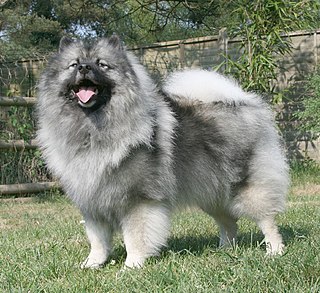
The Keeshond is a medium-sized dog with a plush, two-layer coat of silver and black fur with a ruff and a curled tail. It originated in Holland, and its closest relatives are the German spitzes such as the Großspitz, Mittelspitz, Kleinspitz, Zwergspitz (Dwarf-Spitz) or Pomeranian.

The Patterdale Terrier is a breed of dog descended from the Northern terrier breeds of the early 18th century.

The Yorkshire Terrier is a small dog breed of terrier type, developed during the 19th century in Yorkshire, England. Ideally its maximum size is 7 pounds (3.2 kg). A popular companion dog, the Yorkshire Terrier has also been part of the development of other breeds, such as the Silky Terrier. It has a grey, black and tan coat, and the breed's nickname is Yorkie.
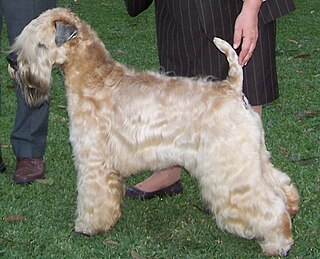
The Soft-coated Wheaten Terrier is a pure breed terrier originating from Ireland. Wheatens typically have one of two coat types: Irish or Heavy (American). The Irish coat is generally silkier and wavier than the Heavy, or American coat, which is thicker and fuller. Wheatens are generally friendly and playful, and tend to get along well with children and other dogs.

The Bedlington Terrier is a breed of small dog named after the mining town of Bedlington, Northumberland in North East England. Originally bred to hunt vermin the Bedlington Terrier has since been used in dog racing, numerous dog sports, as well as in conformation shows and as a companion dog. It is closely related to the Dandie Dinmont Terrier, Whippet and Otterhound.

The Irish Terrier is a dog breed from Ireland, one of many breeds of terrier. The Irish Terrier is considered one of the oldest terrier breeds. The Dublin dog show in 1873 was the first to provide a separate class for Irish Terriers. By the 1880s, Irish Terriers were the fourth most popular breed in Ireland and Britain.

The Toy Fox Terrier is a small terrier breed of dog, directly descended from the larger Fox Terrier but considered a separate breed.

The Toy Manchester Terrier is a breed of dog, categorized as a terrier. The breed was bred down in size in North America from the Manchester Terrier, and is placed in the Toy Group by the American Kennel Club and the Canadian Kennel Club. Neither the Fédération Cynologique Internationale nor The Kennel Club recognize a Toy variety of the Manchester Terrier.
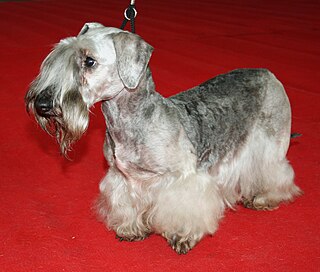
The Cesky Terrier is a small terrier type dog originating in Czechoslovakia.

The Norwich Terrier is a breed of dog originating in the United Kingdom, and was bred to hunt small vermin or rodents. With a friendly personality, Norwich Terriers are today mostly a companion dog breed. One of the smallest terriers, these dogs are generally healthy, but are relatively rare, due in part to their low litter size and the common need for caesarian sections. Their drop-eared variety is the Norfolk Terrier. Recognized as the "official breed of England" in 1932, Norwich Terriers have been delighting owners around the world as a hardworking, loyal companion dogs for nearly a century.

The Miniature Pinscher, also known as the Zwergpinscher, and Min Pin, is a small breed of dog of the pinscher type originating from Germany. The breed's earliest ancestors may have included the German Pinscher mixed with Italian greyhounds and dachshunds.

Havanese is the national dog of Cuba, developed from the now extinct Blanquito de la Habana. The Blanquito descended from the also now-extinct Bichón Tenerife. It is believed that the Blanquito was eventually cross-bred with other Bichon types, including the Poodle, to create what is now known as the Havanese. Sometimes referred to as "Havana Silk Dogs", this was originally another name for the Blanquito de la Habana.
Canine terminology in this article refers only to dog terminology, specialized terms describing the characteristics of various external parts of the domestic dog, as well as terms for structure, movement, and temperament. This terminology is not typically used for any of the wild species or subspecies of wild wolves, foxes, coyotes, dholes, jackals or the basal caninae. Dog terminology is often specific to each breed or type of dog. Breed standards use this terminology in the description of the ideal external appearance of each breed, although similar characteristics may be described with different terms in different breeds.

The Cane Corso (pronounced kah-neh kor-so [ˈkaːne ˈkɔrso] from Italian cane and "corso" meaning from Latin "Cǒhors", is a large dog breed of Southern Italian origins that is used as a guardian, and for protection, tracking and as a police dog.

The Australian Silky Terrier or simply Silky Terrier is a small breed of dog of the terrier dog type. The breed was developed in Australia, although the ancestral types and breeds were from Great Britain. It is closely related to the Australian Terrier and the Yorkshire Terrier. The breed is called the Silky Terrier in North America, but is called the Australian Silky Terrier in its country of origin and in the rest of the world.
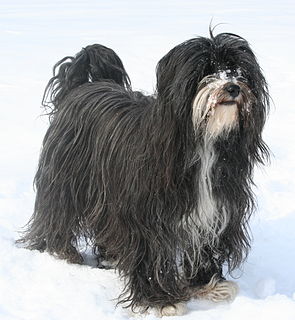
The Tibetan Terrier is a medium-size breed of dog that originated in Tibet. Despite its name, it is not a member of the terrier group. The breed was given its English name by European travelers due to its resemblance to known terrier breeds. The Tibetan name for the breed, Tsang Apso, roughly translates to "shaggy or bearded ("apso") dog, from the province of Tsang". Some old travelers' accounts refer to the dog as Dokhi Apso or "outdoor" Apso, indicating a shaggy or bearded working dog which lives outdoors.

The Norrbottenspets is a breed of dog of the spitz type. It is a breed whose original purpose was a farm and hunting dog but has recently become more popular as a companion dog. The Norrbottenspets is used to hunt wood grouse, black grouse, capercaillie and hazel grouse, but also fox, marten and raccoon. Some individuals are also effective with mammals as large as moose and grizzly bear. Norrbottenspets was formerly used in hunting squirrels, when squirrel fur was valuable in the beginning of the 20th century and earlier.

The Caucasian Shepherd Dog is a large guard dog breed from the Caucasus Mountains, commonly bred in the mountainous regions of Transcaucasia.
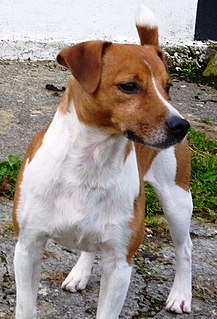
The Plummer Terrier is a working terrier.

The Russian Toy is a very small breed of dog originally bred in Russia from the English Toy Terrier. There are two types of coats in the breed: smooth coat and long coat. The smooth-coated variety was previously known as the Russian Toy Terrier and long-coated as the Moscow Long Haired Toy Terrier. Both were brought together under the same Russian Toy Terrier name in 1988 and the "Terrier" was dropped from the name when the breed was added in 2006 to the official list of breeds registered with the Fédération Cynologique Internationale and has been registered in the Foundation Stock Service of the American Kennel Club since 2008, allowed to compete in AKC companion events since 2010. The first official breed standard of the two varieties was written in 1966 in Russia.



















